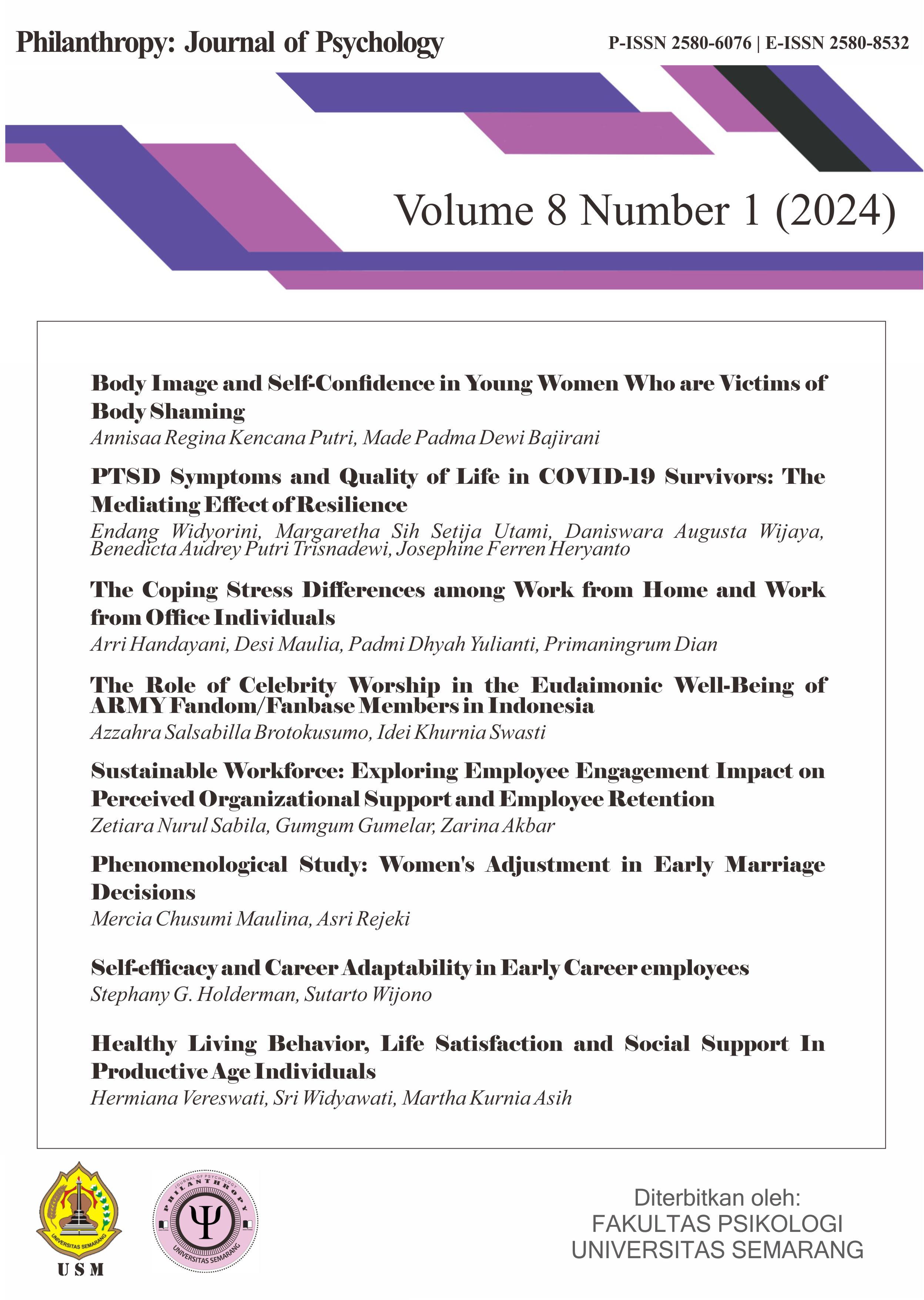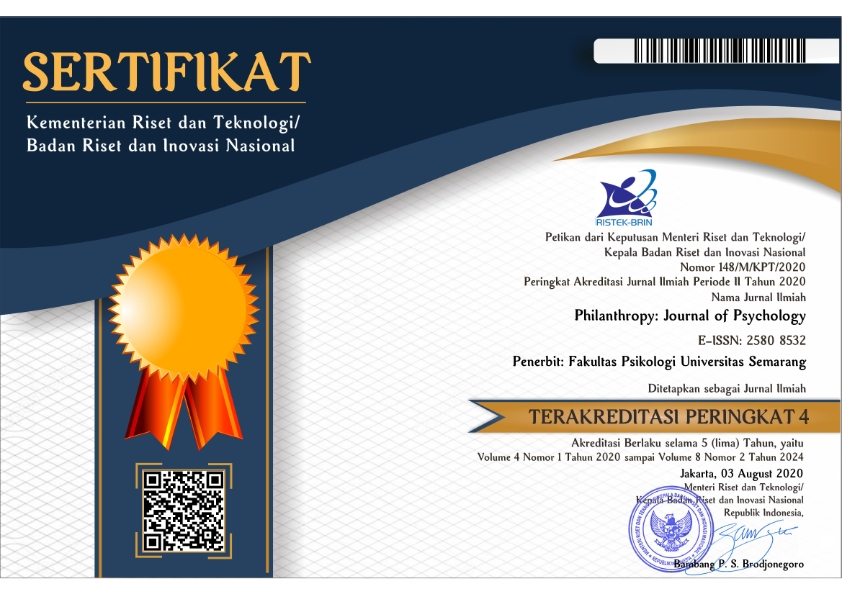The Coping Stress Differences among Work from Home and Work from Office Individuals
DOI:
https://doi.org/10.26623/philanthropy.v8i1.8742Abstract
Abstract. Working from home and working permanently in the office (work from office) have their problems. These differences indeed lead to different responses in coping with stress. This research aims to analyze the differences in coping with stress in individuals who experience work-from-home and work-from-office periods, as well as analyze coping strategies during the work-from-home period. This research uses a quantitative method, using a t-test. The sampling technique uses purposive random sampling, with the characteristics of the population being married and having children, working in agencies either from home or the office. Data collection techniques used a stress coping scale and an open questionnaire regarding identifying feelings and problems that arise, expressed via Google Forms. Quantitative analysis is carried out using t-tests and descriptive analysis. Based on the Mann-Whitney test, the Mean Rank or average group ranking was obtained, namely for work from home, it was 95,15, and work from office was 94.54 with a significance value of (0.947) > 0.05. The quantitative research results show no difference in coping with stress between individuals who experience the work-from-home period and during the work-from-office period. Meanwhile, the results of the descriptive analysis show that the most dominant feeling during the work-from-home period is anxiety, anxiety, or worry (40.74%), while the problem most frequently experienced by respondents is difficulty dividing their time between office work and homework (26.45 %). In general, coping strategies overcome feelings of worry by conveying hobbies (23.28%), while coping strategies overcome problems during the work-from-home period by interacting online (26.45%) and doing good time management (17.98%).
Keywords: Coping Stress; Work from Home; Work from Office
References
Abdullah, N. A. A., Rahmat, N. H., Zawawi, F. Z., Khamsah, M. A. N., & Anuarsham, A. H. (2020). Coping With Post Covid-19: Can Work From Home Be a New Norm? European Journal of Social Sciences Studies, 5(6), 61–81. https://doi.org/10.46827/ejsss.v5i6.933
Afini, M. (2021). Stresor dan Penanggulangan Stres Selama Masa Awal Pandemi Covid-19. 10(3), 294–305. https://doi.org/10.30872/psikostudia
Agárdi, I., Alt, M. (2022). Do digital natives use mobile payment differently than digital immigrants? A comparative study between generation X and Z. Electron Commer Res . https://doi.org/10.1007/s10660-022-09537-9
Ali, A., Khan, A.A., Abbas, S. et al. (2022). Cognitive appraisal, Coping, Stress and Fear Contracting Covid-19 in Working People in Pakistan. J Rat-Emo Cognitive-Behav Ther 40, 663–682. https://doi.org/10.1007/s10942-021-00433-z
Ashal, R. A. (2020). Pengaruh Work From Home terhadap Kinerja Aparatur Sipil Negara di Kantor Imigrasi Kelas I Khusus TPI Medan. Jurnal Ilmiah Kebijakan Hukum, 14(2), 223. https://doi.org/10.30641/kebijakan.2020.v14.223-242
Ariyani, I. (2020). Penyesuaian Setting Ruang Untuk Bekerja Dari Rumah pada Masa Pandemi Covid-19. Jurnal Pengetahuan dan Perancangan Desain Interior, 8 (1), 9-22
Ayar, D., Karaman, M.A. & Karaman, R. (2022). Work-Life Balance and Mental Health Needs of Health Professionals During COVID-19 Pandemic in Turkey. Int J Ment Health Addiction 20, 639–655 https://doi.org/10.1007/s11469-021-00717-6
Carlson, D. S., Grzywacz, J. G., & Michele Kacmar, K. (2010). The relationship of schedule flexibility and outcomes via the work-family interface. Journal of Managerial Psychology, 25(4), 330–355. https://doi.org/10.1108/02683941011035278
Cho, G., Hagen, D. & Goldmann, E. (2023). Pre-pandemic mental health and coping strategy usage during the COVID-19 pandemic: a cross-sectional analysis of the Southern Cities Study. BMC Psychiatry 23, 530. https://doi.org/10.1186/s12888-023-04987-3
Connor-Smith, J. K., & Flachsbart, C. (2007). Relations Between Personality and Coping: A Meta-Analysis. Journal of Personality and Social Psychology, 93(6), 1080–1107. https://doi.org/10.1037/0022-3514.93.6.1080
Darmajaya, J. B., & Vinahapsari, C. A. (2020). Akademik Pekerja Penuh Waktu. 06(01), 20–28.
Dewi, A. K., & Rahayu, A. (2020). Optimisme dan Keberfungsian Keluarga Hubungannya dengan Subjective Well-Being Pekerja Perempuan yang Work From Home di Kecamatan Tambun Utara Kabupaten Bekasi. Jurnal IKRA-ITH Humaniora, 4(3), 29–36.
Eger, L., Komárková, L., Egerová, D., & Mičík, M. (2021). The effect of COVID-19 on consumer shopping behavior: Generational cohort perspective. Journal of Retailing and Consumer Services, 61(December 2020). https://doi.org/10.1016/j.jretconser.2021.102542
Elsary, A.Y., El-Sherbiny, N.A. (2023). The impact of stress-coping strategies on perceived stress during the COVID-19 pandemic among university students an interventional study. BMC Psychiatry 23, 510. https://doi.org/10.1186/s12888-023-04730-y
Finn, K.M., Halvorsen, A.J., Chaudhry, S. et al. (2020). Does Increased Schedule Flexibility Lead to Change? A National Survey of Program Directors on 2017 Work Hours Requirements. J GEN INTERN MED 35, 3205–3209.. https://doi.org/10.1007/s11606-020-06109-1
Folkman, S., & Lazarus, R. S. (1988). An analysis of coping in a middle-aged community sample. Kango Kenkyu. The Japanese Journal of Nursing Research, 21(4), 337–359.
Gashi, D., Gallopeni, F., Imeri, G. et al. (2023). The relationship between Big Five personality traits, coping strategies, and emotional problems through the COVID-19 pandemic. Curr Psychol 42, 29179–29188. https://doi.org/10.1007/s12144-022-03944-9
Greer, T.W., Payne, S.C. & Thompson, R.J. (2023). Pandemic-Induced Telework Challenges and Strategies. Occup Health Sci 7, 575–602. https://doi.org/10.1007/s41542-023-00151-1
Handayani, A. (n.d.). Keseimbangan Kerja Keluarga pada Perempuan Bekerja: Tinjauan Teori Border. DESEMBER, 21(2), 90–101. Retrieved May 9, 2020, from http://mpsi.umm.ac.id/files/file/30-36 Arri Handayani.pdf
Hilbrecht, M., Shaw, S. M., Johnson, L. C., & Andrey, J. (2008). . Gender Work and Organization, 15(5), 454–476.
Holgersen, H., Jia, Z. & Svenkerud, S. (2021). Who and how many can work from home? Evidence from task descriptions. J Labour Market Res 55, 4. https://doi.org/10.1186/s12651-021-00287-z
I, M. Z., & I, N. H. (2010). A study of occupational stress and coping strategies among correctional officers in Kedah, Malaysia. Jurnal Kesihatan Masyarakat, 16(2), 66–74.
Jaiswal, A., Arun, C.J. (2022). Working from home during COVID-19 and its impact on Indian employees’ stress and creativity. Asian Bus Manage. . https://doi.org/10.1057/s41291-022-00202-5
Kaluza, A.J., van Dick, R. (2023). Telework at times of a pandemic: The role of voluntariness in the perception of disadvantages of telework. Curr Psychol 42, 18578–18589. https://doi.org/10.1007/s12144-022-03047-5
Kholisa, N. (2012). Hubungan Manajemen Waktu dengan Efektivitas Kerja Karyawan. Journal of Social and Industrial Psychology, 1(1), 56–60. https://journal.unnes.ac.id/sju/index.php/sip/article/view/2697
Kubo, H., Katsuki, R., Horie, K. et al. (2023). Risk factors of hikikomori among office workers during the COVID-19 pandemic: A prospective online survey. Curr Psychol 42, 23842–23860. https://doi.org/10.1007/s12144-022-03446-8
Maryam, S. (2017). Strategi Coping. Jurnal Konseling Andi Matappa, 1(2), 101.
Messenger, J. C., & Gschwind, L. (2016). Three generations of telework: New ICTs and the (r)evolution from home office to virtual office. New Technology, Work and Employment, 31(3), 195–208. https://doi.org/10.1111/ntwe.12073
Mihelič, K.K., Lim, V.K.G. & Culiberg, B. Cyberloafing among Gen Z students: the role of norms, moral disengagement, multitasking self-efficacy, and psychological outcomes. Eur J Psychol Educ 38, 567–585 (2023). https://doi.org/10.1007/s10212-022-00617-w
Moh, M. (2020). Moh. Muslim : Manajemen Stress pada Masa Pandemi Covid-19 ” 193. Jurnal Manajemen Bisnis, 23(2), 192–201.
Mukherjee, S., Narang, D. (2023) Digital Economy and Work-from-Home: The Rise of Home Offices Amidst the COVID-19 Outbreak in India. J Knowl Econ 14, 924–945. https://doi.org/10.1007/s13132-022-00896-0.
Mustajab, D., Bauw, A., Rasyid, A., Irawan, A., Akbar, M. A., & Hamid, M. A. (2020). Working From Home Phenomenon As an Effort to Prevent COVID-19 Attacks and Its Impacts on Work Productivity. TIJAB (The International Journal of Applied Business), 4(1), 13. https://doi.org/10.20473/tijab.v4.i1.2020.13-21
Nisa', S.K., Rif'ah, E.N., Rokhmah, D. (2022). Strategi Coping Stress pada Dosen Perempuan yang Melaksanakan Work from Home (WFH) Selama Masa Pandemi COVID-19. Jurnal Ilmu Kesehatan masyarakat, 11(4), 311-321.
Nguyen, T., Pu, C., Waits, A., et al. (2023). Transforming stress program on medical students’ stress mindset and coping strategies: a quasi-experimental study. BMC Med Educ 23, 587. https://doi.org/10.1186/s12909-023-04559-9
Oakman, J., Lambert, K.A., Weale, V.P. et al. (2023). The effect of preference and actual days spent working from home on stress and musculoskeletal pain in older workers. Int Arch Occup Environ Health 96, 1113–1121. https://doi.org/10.1007/s00420-023-01992-7
Obiefuna, E.C., Ojonta, O.I. & Ogbuabor, J.E. (2023). The influence of the COVID-19 pandemic and coping strategies on work operation of nonfarm household enterprises in Nigeria. Environ Dev Sustain. https://doi.org/10.1007/s10668-023-03185-1
Okros, A. (2020). Harnessing the Potential of Digital Post-Millennials. https://doi.org/10.1007/978-3-030-25726-2_8
Oktaviani, E., Ahmad, A., & Muharam, S. (2021). Meningkatkan Pendapatan Masyarakat melalui Home Industri di Masa Pandemi Covid-19 Increasing Community Income Through Home Industry during the Covid-19 Pandemic. November.
Peramesti, N. P. D. Y., & Kusmana, D. (2018). Kepemimpinan Ideal Pada Era Generasi Milenial. TRANSFORMASI: Jurnal Manajemen Pemerintahan, 73–84. https://doi.org/10.33701/jt.v10i1.413
Pratiwi, A. M. A., Pertiwi, M., & Andriany, A. R. (2020). Hubungan Subjective Well Being Dengan Komitmen Organisasi Pada Pekerja Yang Melakukan Work From Home Di Masa Pandemi Covid 19. Syntax Idea, 11(2), 1689–1699.
Putra, S. A., & Setiatin, S. (2021). Strategi Coping dan Implikasinya pada Kondisi Kerja Perekam Medis di RSIA Limijati Bandung. Cerdika: Jurnal Ilmiah Indonesia, 1(8), 1057–1067. https://cerdika.publikasiindonesia.id/index.php/cerdika/article/view/150
Purwanto, A. (2020). Stude Eksplorasi Dampak Work From Home (WFH) terhadap Kinerja Guru selama Pandemi Covid-19. Journal of Education, Psychology, and Counseling, 2(1), 92–100.
Rianto Rahadi, D. (2021). Dilema Work From Home Dimasa Pandemi Studi Kawasan Industri Bekasi. Jurnal Manajemen Dan Bisnis Sriwijaya, 19(1), 1412–4521. http://ejournal.unsri.ac.id/index.php/jmbs
Septiawan, A. P. K. P. & A. (2020). Manajemen Kecemasan Masyarakat Dalam Menghadapi Pandemi Covid-19. Academia, 4(December), 79–87.
Setiawan, N. S., & Fitrianto, A. R. (2021). Pengaruh Work From Home ( WFH ) terhadap Kinerja Karyawan pada Masa Pandemi COVID-19. Edukatif : Jurnal Ilmu Pendidikan, 3(5), 3229–3242.
Setyarini, E., & Indriati, F. (2022). Mewujudkan proactive work behavior dalam implementasi flexible working arrangement pasca pandemi Covid-19. Perspektif, 11(2), 632-642.
Solichin, M.S & Noviana, N.E. (2023). Kecemasan karyawan pabrik dalam menghadapi ancaman resesi ekonomi pasca pandemi covid-19. WIDYALOKA, 10(1), 52–58.
Somasundram, K.G., Hackney, A., Yung, M., et al. (2022). Mental and physical health and well-being of Canadian employees who were working from home during the COVID-19 pandemic. BMC Public Health 22, 1987. https://doi.org/10.1186/s12889-022-14349-5
Tam, M. (2019). Intensi Penggunaan Electronic Wallet Generasi Millenial Pada Tiga Startup “Unicorn” Indonesia Berdasarkan Modifikasi Tam. Jurnal Manajemen, 8(2), 136–145. https://doi.org/10.26460/jm.v8i2.702
Usman, S., Lu, C. & Gao, G. (2023). Flexible job-shop scheduling with limited flexible workers using an improved multiobjective discrete teaching–learning–based optimization algorithm. Optim Eng . https://doi.org/10.1007/s11081-023-09842-8
Vitniawati, V., & Jamiyanti, A. (2021). Status Mental Emosional Karyawan Universitas Bhakti Kencana Saat Menjalani Work From Office. Jurnal Psikologi Insight, 5(1), 100–105. https://ejournal.upi.edu/index.php/insight/article/view/34248
Wahyuni, E. S., & Prasetyaningsih, R. H. (2020). The Pemberdayaan Masyarakat dengan Aktivitas Leisure. Jurnalempathy.Com, 1(2), 125–136. https://doi.org/10.37341/jurnalempathy.v1i2.19
Žiedelis, A., Urbanavičiūtė, I. & Lazauskaitė-Zabielskė, (2023). J. Family boundary permeability, difficulties detaching from work, and work-home conflict: what comes first during the lockdown?. Curr Psychol 42, 24163–24174 https://doi.org/10.1007/s12144-022-03492-2
Zhou, Xj., Huang, S. (2023). A qualitative analysis of stress experiences and coping strategies in adolescents with Crohn's disease. BMC Psychiatry 23, 768. https://doi.org/10.1186/s12888-023-05241-6
Downloads
Additional Files
Published
Issue
Section
License
The author who will publish the manuscript at Philanthropy: Journal of Psychology, agree to the following terms:
- Authors retain copyright and grant the journal right of first publication with the work simultaneously licensed under a Creative Commons Attribution 4.0 International License (CC BY 4.0), that allows others to share the work with an acknowledgment of the work's authorship and initial publication in this journal.
- Authors are able to enter into separate, additional contractual arrangements for the non-exclusive distribution of the journal's published version of the work (e.g., post it to an institutional repository or publish it in a book), with an acknowledgment of its initial publication in this journal.
- Authors are permitted and encouraged to post their work online (e.g., in institutional repositories or on their website) prior to and during the submission process, as it can lead to productive exchanges, as well as earlier and greater citation of published work (See The Effect of Open Access).




